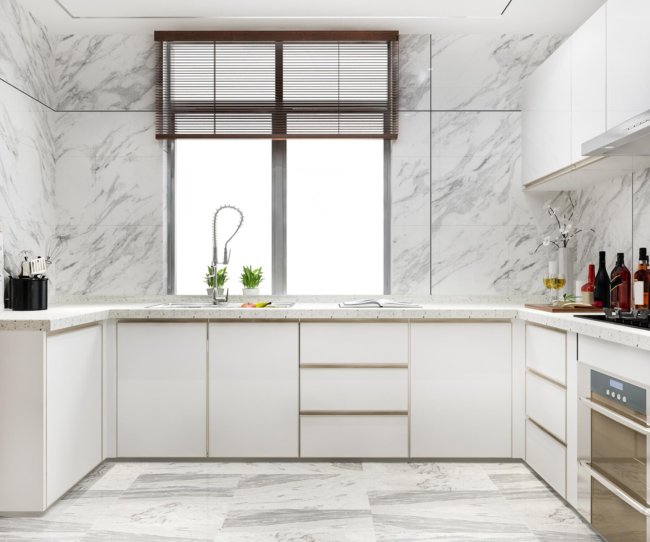
Thinking about new kitchen cabinets but not sure if you should build them yourself or buy them? You’re not alone.
Cabinets are usually the biggest line item in a kitchen budget, and the choice you make here can save (or waste) thousands.
This guide breaks it all down in plain language so you can decide with confidence.
What “Build” and “Buy” Actually Mean
Build (DIY) You cut the parts, assemble the boxes, add face frames or edge banding, make or buy doors, finish, and install. You control every detail—but you also own every mistake.
Buy
- Stock: Pre-made sizes, limited styles, fastest delivery.
- RTA (Ready-to-Assemble): Flat-pack boxes you assemble at home; good value.
- Semi-Custom: You pick sizes and features from a menu.
- Custom: Built to order by a local shop; best fit, highest price.
The Quick Answer (If You’re Skimming)
- Build if you enjoy projects, own basic tools, and have time to learn. Best when you want a special layout or a tight budget.
- Buy if you want a clean, fast result with fewer headaches. RTA is the sweet spot for value; semi-custom if you have tricky spaces.
If you’re unsure, skip to “Smart Hybrid Options” below—you can mix both.
Cost Reality (What People Actually Spend)
Prices vary by region and style, but here’s a real-world ballpark for the cabinet boxes and doors (not countertops or appliances):
| Option | Typical Cost (10×10 kitchen) | Pros | Cons |
| DIY from scratch | \$800–\$2,500 | Lowest cash cost; full control | Takes time; learning curve; finishing mess |
| RTA (assemble yourself) | \$2,000–\$6,000 | Good value; faster than scratch | Limited tweaks; assembly still needed |
| Semi-custom | \$6,000–\$12,000 | Many sizes/features; nicer finishes | Higher cost; longer lead times |
| Custom shop | \$12,000–\$25,000+ | Perfect fit; pro finish | Highest price |
Hidden costs to remember (DIY): saw blades, bits, clamps, finish, sandpaper, mistakes, and time off work.
Time & Skill: Be Honest With Yourself
DIY timeline (from scratch):
- Planning & drawings: 6–12 hours
- Cutting & edge banding: 10–20 hours
- Assembly & squaring: 10–15 hours
- Doors/drawers: 10–25 hours (more if shaker rails)
- Sanding & finishing: 8–20 hours
- Install & trim: 8–16 hours
Total: 3–6 full weekends for a first-timer, more if your layout is large.
RTA timeline:
- Unbox & sort: 2–4 hours
- Assembly: 15–25 minutes per box
- Install: 8–12 hours
Total: 1–2 weekends.
If you’re new to woodworking, start with a small test cabinet: a 24″ base with one drawer and a door. You’ll learn almost every step on a small scale.
The Tools You’ll Actually Use
Must-haves (DIY):
- Circular saw + straightedge guide (or table saw if you have one)
- Drill/driver, countersink bit
- Pocket hole jig or confirmat screws
- Router (for door profiles or flush trimming)
- Random-orbit sander
- Clamps (you never have enough)
- Square, tape, level, stud finder
Nice-to-haves:
- Track saw (clean cuts)
- Brad nailer (faster assembly and trim)
- Spray gun (pro finish)
No fancy shop? You can still build with a circular saw, a router, and a good guide.
Materials: What Makes a Cabinet Strong
- Plywood (cabinet-grade): Strong, lighter than MDF, holds screws well. Great for boxes and shelves.
- MDF: Flat and smooth; perfect for painted doors and panels. Heavy; needs careful handling.
- Particleboard: Cheap and stable when dry; weaker screw hold. Many budget cabinets use it.
Frameless vs. Face Frame
- Frameless (Euro): More storage, clean lines, uses full overlay doors. Needs precise cuts.
- Face Frame: Forgiving during install; classic look. Slightly less interior space.
Hardware that matters
- Soft-close, full-extension undermount slides (e.g., 75 lb or more)
- 35 mm concealed hinges with soft-close
- Leveling feet or a straight, level base
Cheap hardware is the #1 regret. Don’t skimp here.
Quality: What You Can See (and What You Can’t)
Signs of solid construction
- Boxes: ¾” plywood or high-density particleboard; backs at least ⅜”
- Joints: dowels, confirmers, or rabbets; square and tight
- Shelves: ¾” thick with edge banding
- Finish: even sheen, no rough edges
- Doors: stable cores (MDF for paint; stable hardwood rails for stain)
DIY can match or beat store quality if you take your time and use good materials. Where pros win is speed and finishing.
Smart Hybrid Options (Best of Both Worlds)
- Buy RTA boxes, make your own doors → Save money but get a custom style.
- Build boxes, buy doors and drawers → Doors are the fussy part; outsource them.
- Buy uppers, build the island → Showpiece impact with less work.
- Buy everything unfinished, do your own paint → Pro-built, DIY finish.
A Simple Budget Formula (No Surprises)
- Count your boxes (each cabinet carcass).
- Multiply by your cost per box (DIY parts or RTA price).
- Add hardware: slides + hinges + pulls (estimate \$35–\$70 per opening).
- Add finishing supplies: primer, paint/clear coat, sandpaper (estimate \$150–\$400).
- Add install bits: shims, screws, scribe trim, filler panels (estimate \$100–\$300).
- Add 10–20% contingency (mistakes, extra plywood, new blades).
This keeps you honest before you start.
Your Step-by-Step Plan (If You Choose DIY)
- Measure twice: Sketch your kitchen. Mark windows, doors, gas, water, and outlets. Note ceiling height.
- Pick a system: Frameless or face frame? Decide door overlay (full, half, inset). Keep it consistent.
- Standardize sizes: Box depth, toe-kick height, shelf pin spacing. Repeatable sizes save time.
- Make a cut list: Use a spreadsheet or cut-list app. Lay out parts to maximize each sheet.
- Build a level base: For base cabinets, shim a straight ledger or build a platform so all boxes sit dead level.
- Assemble boxes first: Dry-fit, then glue/screw. Check for square (measure diagonals).
- Fit, then face: Install boxes, then scribe fillers, panels, and face frames (if used).
- Hang doors and drawers last: Use jigs for pulls. Adjust until gaps are even and doors close softly.
- Finish smart: Sand to 180–220. Use primer for paint; test color on a scrap. Spray if you can; roll with a fine foam roller if you can’t.
Common Mistakes (and Fast Fixes)
- Out-of-square boxes → Loosen, clamp corner, and re-square using the back panel as a brace.
- Wavy face frames → Plane or sand proud edges, then re-scribe to the wall.
- Drawer rubs or won’t close → Shim slides, check for parallel sides, verify box is plumb.
- Paint shows grain or bumps → Sand, reprime, and apply thin coats; let each coat cure.
- Gaps between cabinets → Use a filler strip or a scribe panel to hide uneven walls.
Safety and Sanity Tips
- Wear eye and ear protection; use a respirator when cutting MDF or spraying.
- Break down sheets on sawhorses with a track/guide—safer than wrestling a table saw alone.
- Label every part with painter’s tape.
- Vacuum dust often; it ruins finishes.
- Take photos and measurements before you tear out the old kitchen.
Installation: The Pro Tricks
- Start in a corner that is plumb and square (or the straightest wall).
- Level line: snap a horizontal line for the tops of base cabinets and bottoms of uppers.
- Screw boxes to studs and to each other through face frames or gables. Clamp first, then fasten.
- Leave reveals: small, even gaps at walls for scribing trim.
- Adjust last: fine-tune doors and drawers when everything else is solid.
Decision Checklist (Print This)
- I have at least two free weekends (RTA) or four+ (DIY from scratch).
- I’m okay learning new tools—or I’ll keep it simple with guides and jigs.
- My layout is mostly standard sizes (easier).
- I’ve priced materials, hardware, and a 15% buffer.
- I know my finish plan (color, sheen, method).
- I can live with small imperfections—or I’d rather pay to avoid them.
If you can’t check most boxes, buy (RTA or semi-custom). If you can, build with a hybrid twist to save time.
Sample Timeline (First-Timer)
- Week 1: Plan, measure, order materials and hardware.
- Week 2: Cut and assemble boxes; dry-fit in place.
- Week 3: Doors/drawers, sand, prime.
- Week 4: Paint/clear coat, install hardware, final install.
Need it faster? Buy RTA boxes and focus on doors and finishing.
Mini-FAQ
Can I build with just a circular saw?
Yes—use a straightedge guide, a fine blade, and cut with the good face down.
Do I have to make my own doors?
No. Many suppliers sell unfinished doors by size. It’s a smart hybrid move.
Paint or stain for beginners?
Paint hides more sins. MDF shaker doors plus a good primer is beginner-friendly.
Will DIY raise home value like store-bought?
Buyers care about the look and function, not the label. Quality install and finish matter most.
If You Decide to Buy: What to Look For
- Box material and thickness (¾” is solid)
- Full-extension, soft-close undermount slides
- 6-way adjustable soft-close hinges
- Real wood or quality veneer face frames; clean edge banding
- Adjustable shelves that don’t sag
- Warranty and lead times you can live with
For RTA, check reviews for fit and squareness, not just style.
If You Decide to Build: Start Smart
- Keep door style simple (Shaker or flat panel).
- Standardize widths (multiples of 3″).
- Use confirmat screws or pocket screws with glue for strong boxes.
- Buy one extra sheet of your main material for fixes.
- Practice your finish on a scrap until you love it.
The Bottom Line
You don’t have to choose all-or-nothing. The smartest path for most people is hybrid: buy where precision and speed matter (boxes, drawers), and build or finish where style and savings show (doors, panels, island).
If you value time and a seamless look, buy RTA—RTA gives great bang for the buck.
If you enjoy the craft and want custom details on a budget, build—just plan well, keep it simple, and protect your finish.
Whichever route you take, measure carefully, invest in good hardware, and leave yourself room—both in budget and in time—for the little surprises every kitchen brings. You’ve got this.
